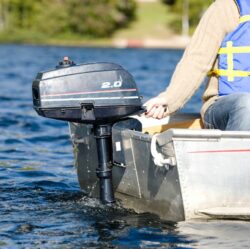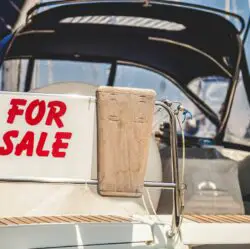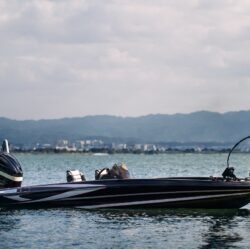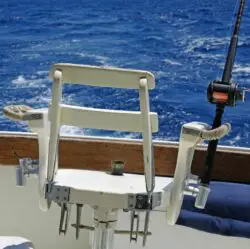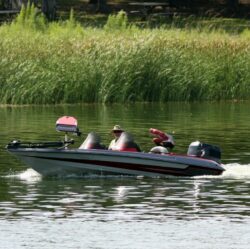*This post may contain affiliate links. As an Amazon Associate we earn from qualifying purchases.
The twinkling sun bounces off the mirror-like lake as your Bass Tracker Boat gently rocks on the calm waters. Isn’t that just the picture-perfect scene to chase away those humdrum Monday blues? Not only do Bass Tracker Boats inspire idyllic dreams, but they’re the craftsman’s pride, the fisherman’s best friend, and your trusty accomplice in waterborne adventures.
With their unique blend of durability, functionality, and chic design, these vessels are truly more than just boats—they’re an ethos of a delightful aquatic life.
But how exactly are these amazing boats made? Is there a special process that they go through? That’s what we will be covering in the article today.
Let’s delve into the fascinating world of Bass Tracker Boats, an entity whose legacy has been inscribed on the world’s water bodies. Picture yourself as a fine observer of this grand spectacle.
As your mind navigates the vivid realm of boat manufacturing, you’ll be privy to the breathtaking precision and the unwavering dedication that goes into the making of each of these magnificent water chariots.
The Design Phase: Engineering Bass Tracker Boats
Casting a net into the sea of imagination, the engineering process of Bass Tracker Boats is akin to a delicate ballet where art meets science. Just as a skilled architect births a blueprint for a grand building, so do boat designers sculpt the initial design of these aquatic wonders.
Utilizing cutting-edge CAD (Computer-Aided Design) software, the designers sketch their dream vessels. Imagine if Leonardo da Vinci had such tools at his disposal—the Mona Lisa might have arrived with jet engines!
Every curve, every line in these designs represents an intricate dance of style and utility, paving the way for an awe-inspiring end product.
The nifty little buttons, the shiny control panels, and the oh-so-comfortable seats—each component is meticulously designed, ensuring the boat not only feels good but looks good too. With a Bass Tracker Boat, you could almost hear your neighbors sigh in envy as you cruise by!
Now, once the design phase wraps up, we venture into a stage that’s quite un-boat-lievably exciting. Can you guess what it is?
Material Selection: The Building Blocks of Bass Tracker Boats
For those of you who guessed the ‘material selection’ stage, well, you’ve hit the nail on the head! As anyone who has ever tried to mold a balloon into a full-size car would tell you, picking the right materials for your project is key.
And with Bass Tracker Boats, this is no small feat!
High-quality aluminum forms the core of these boats, chosen for its strength, lightness, and resistance to rust. Imagine if you could make your boat out of your grandma’s homemade fudge—sounds amazing, right?
Sadly, the sun might turn your sweet dreams into a sticky mess! Hence, aluminum takes center stage in the Bass Tracker’s symphony.
We could go on and on about fiberglass and marine-grade plywood—materials that add to the boat’s resilience. Let’s just say these materials are the boats’ equivalent of a superhero suit, rendering them robust and ready to face the adventures that lie ahead.
These aren’t just boats; they’re finely tuned machines, prepared to defy the elements and turn your aquatic dreams into reality.
Much like choosing the ingredients for your secret chili recipe, the material selection process requires great care, precision, and a ‘boat-load’ of knowledge. It’s like looking for the right cheese to match your wine or finding the perfect dress for that fancy soirée.
The materials need to play well with each other, promising you a smooth, secure, and splendid ride on the waves.
At this stage, the Bass Tracker Boat is akin to a cake in the oven, with all the ingredients mixed together. All it needs is some baking, or in our case, a fine fabrication process. And, here we go!
Fabrication Process: Creating the Bass Tracker Boat Structure
Like a baker meticulously kneading dough to prepare that perfect loaf of bread, the fabrication process is where the chosen materials are manipulated into the desired shape and form.
This process isn’t as simple as inflating a balloon into a sausage dog at your child’s birthday party, oh no! It requires the utmost precision, the kind that would make a Swiss watchmaker nod in approval.
Now, let’s glance at some of the key steps involved in this procedure:
- Welding: The aluminum components are welded together, forming the skeleton of the boat. This is no different than carefully assembling a Lego set, where each block plays a vital part in the overall structure.
- Shaping: The materials are then shaped according to the design plans, a process quite similar to trimming your topiary into a glorious flamingo.
- Finishing: Finally, the structure is polished and refined, ensuring all surfaces are as smooth as a baby’s bottom.
During the process, skilled craftsmen and sophisticated machines are in a harmonious tango, working hand in hand. Picture this as a fantastic orchestra, with both humans and technology playing their unique symphony.
By the end of the fabrication process, what was once a flat sheet of aluminum has transformed into a beautiful 3D structure, ready to conquer the waterways.
Assembling the Hull: The Foundation of Bass Tracker Boats
Next up is the hull assembly. If the boat were a knight, then the hull would certainly be its steadfast shield!
It’s a crucial part that provides the boat with buoyancy and stability. Consider this the boat’s unsinkable spirit—quite literally!
The hull of a Bass Tracker Boat is built in a two-part process:
- Creating the hull: The lower part of the boat, also known as the hull, is welded together. This isn’t as easy as piecing together a jigsaw puzzle, but the craftsmen at Bass Tracker Boats make it look like a piece of cake!
- Adding the ribs: Once the hull is ready, it’s time to add the ‘ribs’. These ribs are longitudinal strips of aluminum that provide structural support to the boat, much like how your ribs support your body.
And voila! You have a hull that’s as sturdy as a knight’s armor, promising to keep you afloat amidst the most turbulent waves. It’s the unsung hero of the boat, quietly doing its job while you bask in the sun or reel in that impressive bass.
Remember my dear reader, much like the tallest towers, the grandest boats too have humble beginnings. And as we move from the foundation to the deck, the boat begins to take a form you’d recognize, a form that’s ready to part the waters and make waves!
Installing the Deck: Bringing Functionality to Bass Tracker Boats
A boat without a deck is like a bird without wings—it just won’t fly! A deck is where the real action happens. It’s the stage where you perform your role as the captain, the fisherman, or the sunbather.
Installation of the deck involves:
- Creating the deck: Craftsmen use CAD designs to shape and form the deck, ensuring precision and quality.
- Wiring: Essential wiring for navigational lights, control panels, and other electronics are added. Think of it as the boat’s nervous system, sending signals from the helm to the rest of the vessel.
- Installing fixtures: Finally, fixtures such as rod holders, cup holders, and seats are installed. These are like the icing on the cake, adding functionality and comfort to your ride.
Each part of the deck is designed with a keen eye, much like how a seasoned gardener arranges her flower beds. Every fixture has its purpose, every wire its function, all coming together in a harmonious symphony of practicality and style.
As we continue this journey of discovery, remember that every rivet, every seam, every polished surface bears the mark of a craftsman’s pride, the same pride you’ll feel as you commandeer your Bass Tracker Boat across the tranquil lake or the rushing river.
Outfitting the Interior: Crafting Comfort in Bass Tracker Boats
Stepping into the interior of a Bass Tracker Boat is like walking into a finely curated nautical suite. Each aspect is tailored for a comfortable and engaging journey. It’s not just about getting from point A to point B—it’s about relishing the voyage and feeling at home while you’re at it!
Let’s sneak a peek at the process of outfitting the interior:
- Designing: Based on the boat model, a suitable interior design plan is drafted. This isn’t simply about slapping a few seats and calling it a day. It’s a meticulous process that ensures a balance of aesthetics and ergonomics.
- Installing seats: Next, marine-grade seating is installed, promising a comfortable ride, even on choppy waters. Imagine having your favorite armchair with you as you sail—now, isn’t that delightful?
- Setting up controls: The helm is then outfitted with necessary controls and instruments. These are placed strategically, ensuring easy access and operation, so you can feel like a seasoned skipper at the wheel.
- Adding amenities: Finally, additional amenities like storage compartments, fish finders, live wells, etc., are installed. These are like the cherries on top of your boating sundae!
From the soft hum of the engine to the gentle sway as the boat cuts through the water, every experience on a Bass Tracker Boat is designed to leave you wanting more. It’s like having your own personal oasis amidst the water, a place where you can unwind, entertain, and engage in your favorite aquatic activities.
Powering Up: The Engine Installation in Bass Tracker Boats
Imagine going on a road trip, but you forget to fill up the tank. Sounds like a recipe for disaster, right? That’s where the engine comes in, the beating heart of your Bass Tracker Boat.
The engine installation process involves:
- Selecting the right engine: Depending on the boat’s size and intended use, the perfect engine is chosen. This isn’t as simple as picking an apple from a tree; it requires in-depth knowledge of marine engines and their specifications.
- Installation: Once the engine is chosen, it’s securely installed at the stern of the boat.
- Connecting to the helm: The engine is then connected to the boat’s helm, linking the controls to the engine. It’s like connecting the puppet to its strings, ready to dance at the puppeteer’s command.
- Testing: Finally, the engine is tested for performance and efficiency, ensuring it’s ready to take on the waters.
Each engine roars to life with the promise of power and performance. Whether you’re in a mood for a slow, leisurely ride around the lake or a thrilling race across the waves, the engine of your Bass Tracker Boat is ready to deliver.
As we navigate the fascinating world of Bass Tracker Boats, remember that every piece, every part, and every process is a testament to years of experience, innovation, and a passion for crafting the finest boats.
Whether you’re a seasoned sailor or a landlubber with dreams of the sea, a Bass Tracker Boat is more than just a vessel—it’s a key to an enchanting aquatic world.
Quality Checks: Ensuring Perfection in Bass Tracker Boats
Next up on our journey is the quality check stage. It’s like that final scan you give your outfit before you step out for a night on the town.
You want to ensure that every part is in its place, every thread is tucked away neatly, and everything looks just perfect!
Quality checks at Bass Tracker Boats involve:
- Visual inspection: Each boat undergoes a thorough visual inspection. This is like combing through a novel for any spelling mistakes or grammatical errors, ensuring everything looks just right.
- Performance testing: The boat is then subjected to a series of performance tests. It’s akin to a race car driver taking their vehicle for a spin before the big race, checking for any potential issues.
- Safety checks: Finally, safety checks are conducted to ensure the boat meets all safety standards and regulations. This is as crucial as buckling up before you start your car—it’s all about ensuring a safe and secure experience on the water.
By the time the boat passes the quality checks, it’s a certified masterpiece, ready to embark on countless adventures.
Launching: Sending Bass Tracker Boats to Their New Homes
The time has come for the boats to leave the nest and embark on their journey to their new homes. It’s like seeing your child off on their first day of school—a bittersweet moment filled with pride and anticipation.
The launching process for Bass Tracker Boats involves:
- Preparation: The boat is given a final clean and polish, making sure it looks its best for its new owner.
- Packaging: The boat is then carefully packaged to prevent any damage during transportation. Imagine wrapping a delicate porcelain vase for shipping—you want it to reach its destination in pristine condition.
- Shipping: Finally, the boat is shipped off to its new home, ready to create a splash!
After-Sale Services: Ensuring a Smooth Sail for Bass Tracker Boats Owners
Just like any relationship, the bond between a Bass Tracker Boat and its owner doesn’t end at the point of sale. The company provides excellent after-sale services, ensuring owners have a smooth and enjoyable boating experience.
After-sale services include:
- Maintenance tips: Owners are provided with detailed maintenance guidelines to help keep their boat in top condition. Think of it as a guide to nurturing a bonsai tree—each tip helping you care for your precious possession.
- Repair and servicing: Should you ever face any issues, Bass Tracker Boats offer repair and servicing options to get your vessel back in perfect shape.
- Customer support: If you have any queries or concerns, their customer support is just a call away, ready to assist you.
- Upgrade options: If you ever want to enhance your boat with new fixtures or amenities, Bass Tracker Boats offers a range of upgrade options.
By offering comprehensive after-sale services, Bass Tracker Boats ensures that owning a boat is a delightful and rewarding experience.
Conclusion: Bass Tracker Boats – A Journey of Craftsmanship and Commitment
Through each stage of production—from the initial design to the final quality checks—Bass Tracker Boats demonstrate an unwavering commitment to quality, performance, and customer satisfaction.
Owning one of these vessels is like joining an exclusive club—a community of boating enthusiasts who value craftsmanship, adventure, and the simple joy of spending time on the water.
Whether you’re an angler hoping to catch the next big fish, a water sports enthusiast seeking your next thrill, or simply someone who cherishes the calm and serenity of a day on the lake, there’s a Bass Tracker Boat waiting to make those experiences unforgettable.
As we conclude our fascinating tour, remember: each Bass Tracker Boat carries with it a story—a story of precision, dedication, and passion for the open water. And with every boat that sails off into the sunset, a new chapter in that story begins.

